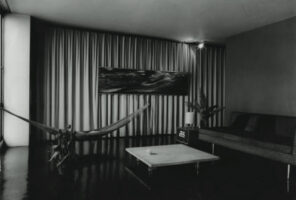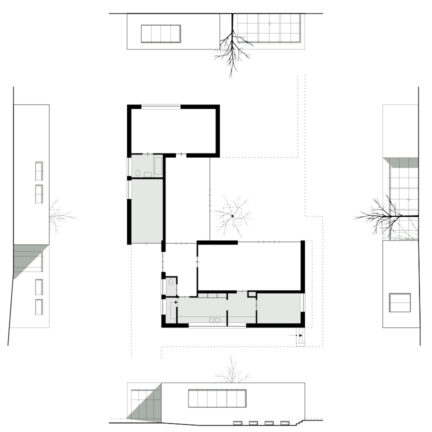Mies
Published as Carpenters Eye column on: website Architectenweb, mei 2020
 We cycled twenty kilometres through Berlin in search of Haus Lemke, designed by Ludwig Mies van der Rohe. ‘A garage’ our adolescents had established. ‘Come on, let’s move to Berlin’ my beloved said. She was right. It is one of the few houses in the architectural canon in which I can picture us living.
We cycled twenty kilometres through Berlin in search of Haus Lemke, designed by Ludwig Mies van der Rohe. ‘A garage’ our adolescents had established. ‘Come on, let’s move to Berlin’ my beloved said. She was right. It is one of the few houses in the architectural canon in which I can picture us living.
What is the reason for this? I am not a professing Modernist. The divine battle of ideas in Modernism is soporific. Demigod Peter Smithson wasn’t the only one to reduce Modernism to a duel between its two supreme gods. ‘Mies is great, but Corb communicates’ he groaned.
Back from holiday, I got into trouble with a cross-thinking architectural twitic. I had called Le Corbusier a boring man who made boring buildings. In between two of its restorations I once visited Villa Savoye, which he had designed. That may be a villa, but it is definitely not a house. Rather, it seemed to me to be a rattling design shack, which only served as a backdrop for photos and parties – and for photos of parties. The chapel in the Jura, Notre Dame du Haut, has certain merits. However, this structure is also ultimately a draughty barn. And then those thick layers of paint everywhere; Corb supplied his buildings with make-up abundantly. 100 years after the Citrohan house, I was hearing the despair of the twitic about my faithlessness.

In Berlin we succumbed to Haus Lemke’s makeup-less brick modernism. The benefits of the house don’t come across as a forced, aestheticised ideal of living. It is up to the residents to personalise the house and provide it with things (and paint). The design establishes the relationship between the street, the house and the garden and regulates the spatial relationships between the three living rooms. Haus Lemke anticipates the conventions of living. We imagined how the house would tolerate the disorderly stuff of our combined household goods. In this regard, as a visitor, there is a lot you don’t get to see. The garage, sanitary rooms, storage rooms, kitchen and pantry are housed in an almost closed zone. There is a spacious basement. By the grace of the service areas, our living space wouldn’t clog up. A cunning house, Haus Lemke.
I spoke to Charlotte. In her own words, she ‘grew up in Mies.’ As a young architects couple, her parents had acquired a flat on Lake Shore Drive in Chicago. Photographs of Charlotte’s youth are meticulously composed, black and white, and serene. She plays with blocks on a shiny cast floor. Curiously, the interior is quite dark. In the background you see curtains hung in front of the glass curtain wall, forming the backdrop for abstract paintings that are hung in front of the curtains. A hammock hangs across the room. There are a few Thonet chairs. A travertine plate, frozen off from the entrance platform of the building, serves as a side table.

Charlotte’s childhood memories illustrate the metropolitan joy of life in Chicago in the 50s and 60s. Mies, Myron Goldsmith, Bertrand Goldberg, Charles Genther, Harry Weese and Charles Murphy got drunk in the house of her parents, who were a generation younger. Sardonic were the congratulations to an attendee who had the honour to supply new curtains for the Farnsworth House when it was flooded for the very first time.
Mies himself had no appetite for complicated lift conversations and lived in an old house down the road. Excited, the photographer Harry Callaghan jumped on his lap there, breaking the fragile back of the chair. Mies always left the damaged Eames chair in place.
Lake Shore Drive was stylish. Pets were forbidden and initially silver curtains were required. Later vertical and horizontal blinds were allowed as long as they were grey. It was up to the residents to personalise their accommodation. The houses of Charlotte’s girlfriends were often less tasteful. They were full of fake panache or were ahead of Post-Modern kitsch. Nowadays, Lake Shore Drive is a home to wealthy people and architects. Flats have been pulled together. People even seem to have merged two entire floors into a huge duplex house. You could call that urbanisation. ‘Mies takes all sorts of shit,’ says Charlotte.

Being great is good enough. Architecture is an applied art with limited communicative possibilities. What does Corb’s paint actually tell us? Celebrating the pleasure of the hammock, Mies’s broken Eames chair and the frost damaged travertine plate point in a different direction. Opposite Corb’s humourless evangelism is Mies’s silent joie de vivre. He practised in an imperfect reality and – most of the time – stopped designing in time.
Our adolescents were euphoric when they found out that the Russian occupying forces had actually used Haus Lemke as a garage. Mies takes all sorts of shit.
Photo provided by Charlotte Myhrum, text editing English translation: Charles Rattray
